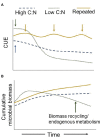Managing Agroecosystems for Soil Microbial Carbon Use Efficiency: Ecological Unknowns, Potential Outcomes, and a Path Forward
- PMID: 31178846
- PMCID: PMC6543778
- DOI: 10.3389/fmicb.2019.01146
Managing Agroecosystems for Soil Microbial Carbon Use Efficiency: Ecological Unknowns, Potential Outcomes, and a Path Forward
Abstract
Agricultural systems are increasingly managed for improving soil carbon (C) accumulation. However, there are limits to C returns in agricultural systems that constrain soil C accumulation capacity. Increasing the efficiency of how soil microbes process C is gaining interest as an important management strategy for increasing soil C and is a key feature of soil C dynamics in many new microbial-explicit models. A higher microbial C use efficiency (CUE) may increase C storage while reducing C system losses and is a fundamental trait affecting community assembly dynamics and nutrient cycling. However, the numerous ecological unknowns influencing CUE limit our ability to effectively manage CUE in agricultural soils for greater soil C storage. In this perspective, we consider three complex drivers of agroecosystem CUE that need to be resolved to develop effective C sequestration management practices in the future: (1) the environment as an individual trait moderator versus a filter, (2) microbial community competitive and faciliatory interactions, and (3) spatiotemporal dynamics through the soil profile and across the microbial lifecycle. We highlight ways that amendments, crop rotations, and tillage practices might affect microbial CUE conditions and the variable outcomes of these practices. We argue that to resolve some of the unknowns of CUE dynamics, we need to include more mechanistic, trait-based approaches that capitalize on advanced methods and innovative field research designs within an agroecosystem-specific context. By identifying the management-level determinants of CUE expression, we will be better positioned to optimize CUE to increase soil C storage in agricultural systems.
Keywords: CUE; agriculture; carbon sequestration; crop diversity; microbial biomass; soil ecology; tillage.
Figures


References
-
- Abramoff R., Xu X., Hartman M., O’Brien S., Feng W., Davidson E., et al. (2018). The Millennial model: in search of measurable pools and transformations for modeling soil carbon in the new century. Biogeochemistry 137, 51–71. 10.1007/s10533-017-0409-7 - DOI
-
- Behrens S., Kappler A., Obst M. (2012). Linking environmental processes to the in situ functioning of microorganisms by high-resolution secondary ion mass spectrometry (NanoSIMS) and scanning transmission X-ray microscopy (STXM). Environ. Microbiol. 14, 2851–2869. 10.1111/j.1462-2920.2012.02724.x, PMID: - DOI - PubMed
LinkOut - more resources
Full Text Sources

